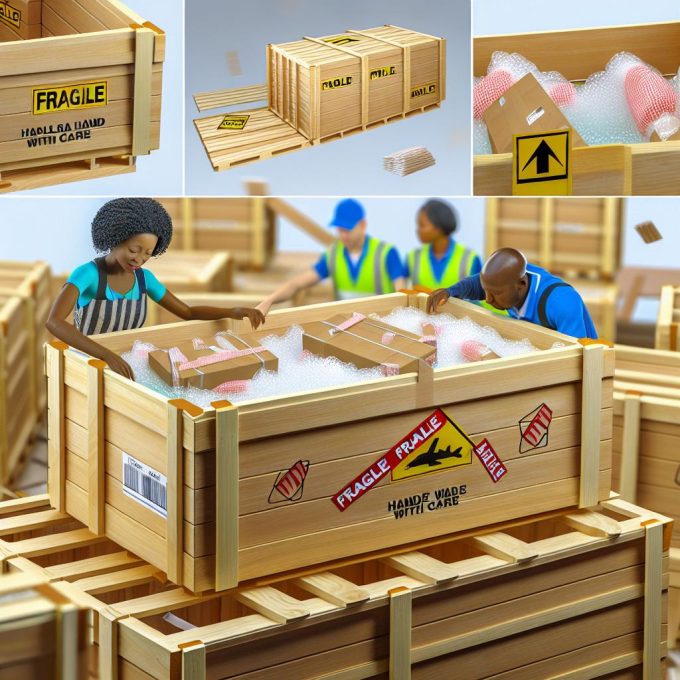Understanding the Importance of Wooden Crates for Fragile Shipments
When shipping delicate items, ensuring their safe arrival is essential. Wooden crates are an indispensable component in this shipping process due to their resilience and ability to safeguard sensitive contents. This document will examine why wooden crates are a valuable choice for fragile shipments and the elements to assess when selecting the right crate.
The Durability and Protection Offered by Wooden Crates
Wooden crates are well-known for their strength and enduring nature. The robustness of wood makes it a suitable material capable of enduring the various stressors encountered during transportation. The structural solidity provided by wooden crates plays a significant role in minimizing the risk of damage to delicate items.
Furthermore, wooden crates offer extensive protection due to their capacity to absorb impact effectively. This property is particularly advantageous for the transportation of breakable items such as glassware, ceramics, and electronic components. By dispersing shock across the crate’s surface area, wooden crates reduce the direct impact on the contents inside.
Customizability of Wooden Crates
A major advantage of wooden crates is their potential for customization to meet specific shipping needs. Custom crates ensure items are securely packed, reducing the movement within the crate. This diminishes the risks posed by impacts and vibrations that might occur during transit.
Numerous businesses offer custom crate manufacturing services, providing options for alterations in crate dimensions, wood types, and additional reinforcements to enhance safety. For individuals seeking more on tailored crate solutions, visiting specialized services online can be informative.
Factors to Consider When Choosing Wooden Crates
Selecting the appropriate wooden crate involves several vital considerations, particularly when dealing with fragile items:
**Size and Weight Capacity:** An essential factor is choosing a crate that can accommodate the specific dimensions and weight of the items being shipped. Overloading a crate could potentially undermine its structural stability.
**Type of Wood Used:** Different wood types offer varying degrees of sturdiness and resistance to environmental conditions. Common choices include pine and hardwood, each bringing unique advantages.
**Moisture Resistance:** The shipping environment may necessitate consideration of moisture resistance. Some wood varieties naturally offer increased resistance to moisture, whereas others may require additional protective treatments.
**Cost Considerations:** Although customized wooden crates can entail greater expenses compared to standard options, the extended protection they afford might justify the higher cost, particularly in shipping high-value, fragile items.
Additional Considerations for Wooden Crates
Besides the fundamental aspects of size, type of wood, and moisture resistance, further factors could influence the selection of wooden crates for shipping:
Environmental Impact: The production and disposal of wooden crates may have environmental implications. Opting for sustainably sourced wood can mitigate the environmental impact. Businesses focused on eco-friendly practices might also consider wood treatments and finishes that are non-toxic and environmentally safe.
*Regulatory Compliance*: Certain regions and industries may have regulations or standards governing packaging materials, especially for international shipments. Ensuring compliance with these standards is crucial to prevent delays or rejections during transit.
Ease of Handling: The design of wooden crates can also influence handling efficiency. Considerations such as the inclusion of lifting handles or forklift access points can facilitate easier and safer transportation, reducing the risk of damage during loading and unloading.
*Reuse and Recycling*: The potential for reuse or recycling of wooden crates can further enhance their value. Durable crates that can withstand multiple uses reduce long-term costs and waste. At the end of their lifecycle, wood can often be recycled, aligning with sustainable practices.
Conclusion
Wooden crates serve as a dependable solution for shipping fragile items, providing essential durability, ample protection, and the option for customization. By taking into account various factors such as size, type of wood, moisture resistance, and additional considerations like environmental impact and regulatory compliance, shippers can identify the most suitable crate for their specific needs. While initial investments may seem substantial, the prospective savings from minimized damage to goods often outweigh the initial expenditures involved with these crates.
This comprehensive understanding underscores the practical benefits of wooden crates in safeguarding fragile shipments, allowing businesses and individuals to make informed decisions that ensure the safe transport of their valuable and delicate items.

